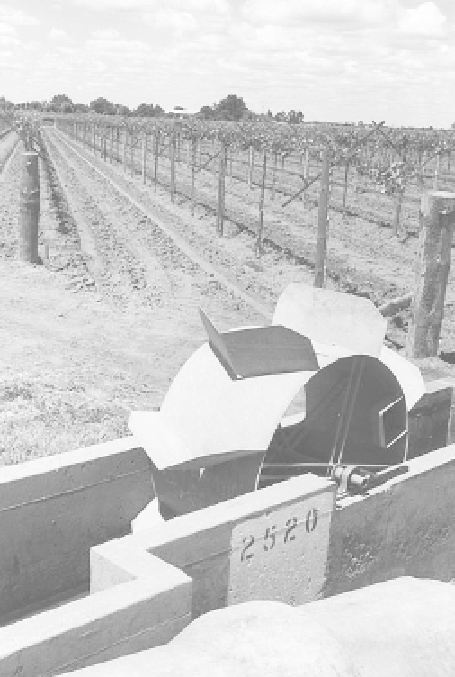Agriculture Reference
In-Depth Information
A furrow irrigation system and
water metering device for a
vineyard in Sunraysia, Australia.
Photograph by the author.
Figure 6.9
but can be part of a “traveling irrigator” that moves along the vine rows, as in the
Coonawarra and Padthaway regions of South Australia.
With
furrow irrigation
, water is diverted from a main ditch generally into a
channel running on either side of each row (fig. 6.9), or sometimes into a single
central channel. For
flood irrigation
, the vineyard is divided into irrigation bays,
and water flows into the bays to cover the entire row and inter-row area (except
where soil is “mounded” along the vine row). Sufficient water must be applied for
soil at the far end of the bay to wet to a desired depth, which often means that
vines at the head of the bay receive too much water. This effect is exacerbated in
long bays on permeable soils. The problem of uneven distribution of water is com-
pounded if there are slight rises and depressions along the bay, because water will
pond in the depressions, where infiltration will be greater. This can be overcome
by leveling the bays with laser-guided graders.
Furrow irrigation is popular in older vineyards of the Lodi District in Cali-
fornia. One advantage of furrow irrigation in this district is that water from sur-
face storages can be used, rather than the scarcer groundwater, which, because of
its lower sediment content, is preferred for drip irrigation. Flood irrigation is com-
mon in older vineyards in Chile, and also occurs in the Riverland, Sunraysia, and
Griffith regions of Australia. Furrow and flood irrigation waste water compared
to drip irrigation (see appendix 10). An example of poor management of flood ir-
rigation is shown in figure 6.10.

